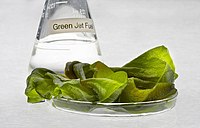
Photo from wikipedia
Abstract Excess sludge is rich in organic matter, nitrogen, and phosphorus. However, in the disposal of industrial wastewater with high concentrations of organic matter, the toxic organics accumulate in the… Click to show full abstract
Abstract Excess sludge is rich in organic matter, nitrogen, and phosphorus. However, in the disposal of industrial wastewater with high concentrations of organic matter, the toxic organics accumulate in the sludge will cause sludge toxicity. Microalgae have strong adaptability to toxic environments. Therefore, in the present study, Chlorella vulgaris was cultured in sludge extract and BG11 medium (blank group) with the objectives of reducing both sludge yield and organic toxicity. The results show that the toxic sludge extract could maintain the stable growth of Chlorella vulgaris, and on the 10th day of culture, Chlorella vulgaris obtained higher biomass and photosynthesis efficiency. The BOD/COD (B/C) ratio of the sludge extract increased from 0.12 to 0.37 while the carbon/nitrogen ratio increased by a factor of 4.9, which significantly improved its biodegradability. Excitation emission matrix analysis showed that C. vulgaris removed soluble microbial products and reduced some humic acids. The isobaric tags for relative and absolute quantitation revealed the presence of differential proteins affecting the processes of small molecule metabolism, energy metabolism, and photosynthesis in different media.
Journal Title: Journal of Cleaner Production
Year Published: 2020
Link to full text (if available)
Share on Social Media: Sign Up to like & get
recommendations!